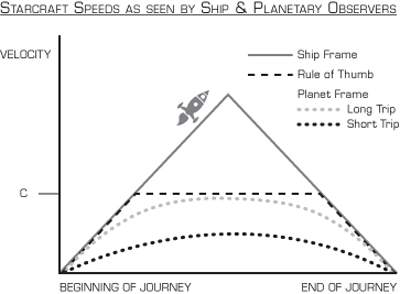
index . chapter one . chapter two
by Roger Bourke White Jr., copyright 1997, August 2002
It takes a long time to travel from one star system to another. Even at the speed of light, it takes four years to travel from our solar system to the Alpha Centuri, the next nearest solar system.
For most science fiction writers, this is too long, so they fabricate some sort of Faster-than-light (FTL) technology so their story line can advance. (Warp, sub-space and hyperspace drives being some perennial favorite names.)
The problem with this is: there is no FTL technology in our real world foreseeable future, and no theoretical breakthrough that would permit one.
In our real world, the fastest ships that can be devised with known sciences and technologies will be constant acceleration ships that can rapidly approach the speed of light, but never surpass it.
What will space travel and space commerce be like with Slower-than-light (STL), constant acceleration propulsion?
How long will it take to get from place to place? There are two answers to this question: how long will it take in the planetary frame of reference, and how long will it take in the space ship frame of reference? The answers are quite different.
What an observer will see from a planetary frame of reference is a ship that accelerates rapidly to near the speed of light, then continues to slowly approach the speed of light until midway through the journey, when it reverses the process and starts slowing down.
The calculation of how long this journey will take can be simplified by assuming that the trip consists of three parts:

Here is the basic math for this simplified calculation:
#1 G=32 ft/sec-sec (Earth's gravity) = 1 LY/yr-yr
This is a simple conversion of units of Earth's gravitational force from those good for Earthly problems (ft/sec-sec) to those good for interstellar space problems (LY/yr-yr).
If a ship accelerates at one G, then it will reach light speed in a year, and have traveled half a light year. So, to get up to light speed, and back down to zero speed (phases 1 and 3), takes two years, and during that time the ship travels one light year.
The rest of the journey takes place at light speed.
So, a journey to Alpha Centuri takes:
Two years to start, stop, and travel one light year plus...
Three years to travel the remaining distance.
Total: Five years.
A trip to Sirius, twelve light years distant, takes thirteen years.
A trip to the Galactic Core, 30,000 light years distant, takes 30,000 years.
Another curiosity emerges: if the ship accelerates at 2G instead of one G, how much does that cut travel time? The answer is: hardly at all! That part of the journey which is taking place at near light speed (phase 2) is unaffected. Journey time to somewhere nearby, such as Alpha Centuri, will be measurably affected, but a journey even to somewhere as distant as Serius will show little change in travel time.
A very simple rule of thumb emerges for calculating the travel times of constant acceleration ships -- as seen from planetary perspective:
Travel time = Take the distance in light years, and add a year.
The travel time in the ship time reference looks quite different. Travel time looks Newtonian, and acceleration does make quite a difference in travel time.
These same journeys experienced from inside the space ship are covered by a completely different formula: it's simply Newtonian d=1/2att. The space ship flying to Alpha Centuri would experience a flight of:
1/2 the journey: t=sqrt(2*2LY/1LY/yr-yr)=2 , full journey = 4 years
The trip to Sirius would be:
1/2 the journey: t=sqrt(2*6LY/1LY/yr-yr)=3.5 , full journey = 7 years
The galactic center would be:
1/2 the journey: t=sqrt(2*15,000LY/1LY/yr-yr)=170 , full journey = 340 years
Note that from the space ship reference acceleration is important to journey time, and note that in ship times these journeys are always much faster than they appear in planetary reference.
Here is a table of these same journeys being undertaken in different acceleration regimes.
| Destination | 1G | 2G | 5G | 10G | Planet time |
|---|---|---|---|---|---|
| Alpha Centauri | 4 | 2.8 | 1.8 | 1.3 | 5 |
| Sirius | 7 | 5 | 3 | 2.2 | 13 |
| Galactic Core | 340 | 244 | 155 | 110 | 30,000 |